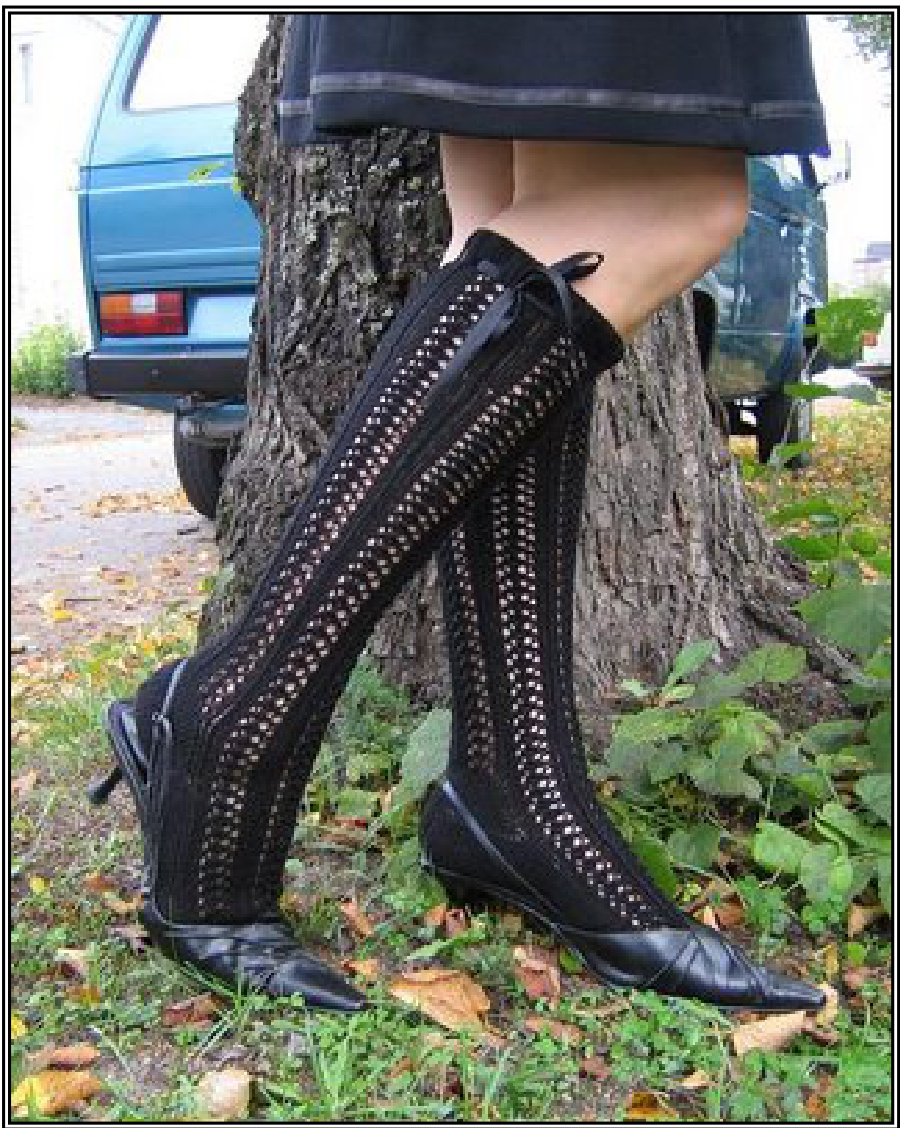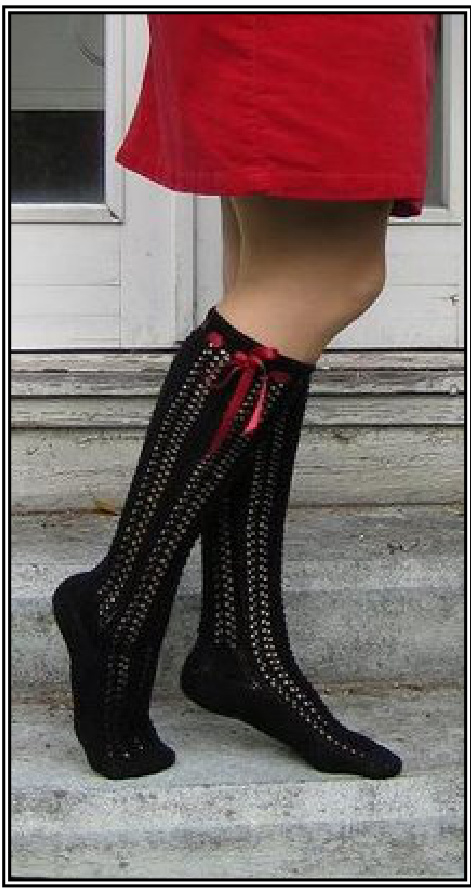SODERA SOCKS
By Vilma Vuori

The Sodera Socks were inspired by Anna socks in Rowan Magazine and Hedera Socks in Knitty. Although the pattern is my own design the Soderas remind the Hedera Socks a lot because of same lace pattern used in both. Therefore I have asked Cookie A., the designer of Hedera Socks, that it is ok by her to publish the pattern. This pattern is for personal use only; please do not sellitems knitted with this pattern! The name Sodera doesn't actually mean anything as such. The Finnish word “sode'" could be translated to “"cute", and the “"era" part is a credit to Cookie A's Hedera Socks, because they inspired me to use that particular lace pattern. The Soderas are fancy show-off socks, romantic lace socks, rock and hard core socks or even gothic depending on in which colour they are knitted in and what clothes and shoes they are worn with. Changing the ribbon in the top of the leg into contrast colour also alters their image. The Sodera Socks are knitted toe-up in order to make it easier to determine when to Start the increases for the calf shaping. It also helps to define when the socks are high enough.
Materials
Yarn
Novita Kotiväki ( $100\,\%$ cotton; 166 meters/182 yards = 50 g, gauge 7,5 sts knitted plain $=$ 1 inch), approx. $130\;\mathrm{g}$ This is a Finnish yarn, and its availability is quite poor outside Finland. You can replace it with any yarn that has approximately same gauge.
Other materials
0,5 cm( $1/5$ inch) wide elastic band approx. 1 meter $(3\,1/3$ fet), 1 cm ( $2/5$ inch) wide satin ribbon 1,5 meters (5 feet), crochet hook (and some sewing yarn and a needle to fasten the elastic band).
Needles
1 set of 5 double-pointed needles or short circular needle 2.5 mm (Us # 1).
Pattern information
Size
The socks in the pictures are women's L (40-41). The size can be easily adjusted by knitting more or less of pattern repeats in the instep. Knitting one pattern repeat less shortens the sock with 1cm( $2/5$ inch) and vice versa.
$30\;\mathrm{{sts}/40-45\;\mathrm{{rows}}=10\;\mathrm{{cm}\left(\right.}}$ 4 inches) knitted plain. One pattern repeat ( $=4$ rounds) on 2,5 mm needles $=$ approx. 1 cm ( $2/5$ inch).
Lace pattern
Round 1: $^{\ast}\mathsf{K}_{1}$ tbl, p2, yo, ssk, k1, k2tog, yo, $\mathsf{p}2^{\star}$ , repeat $*_{-}*$ Rounds 2 & 4: $^{\ast}\mathsf{K}_{1}$ tbl, p2, k5, $\mathsf{p}2^{\star}$ , repeat \*-\*. Round 3: $^{\ast}\mathsf{K}_{1}$ tbl, p2, ki, yo, sl, ktog, pso, yo,k1, $\mathsf{p}2^{\star}$ , repeat \*-\*. Rounds $1{-}4=1$ pattern repeat.

Pattern
Toe Basic instructions onhow to knit a sock toe-up are available for example in on-line knitting magazine Knitty in an article by Wendy D. Johnson (http://www.knitty.com/issuewintero2/FEATtiptoptoes.html). This section of the pattern partly quotes and uses as a guideline the instructions by Kristel Nyberg published in a Finnish on-line knitting magazine Ulla (http://www.ullaneule.net/0305/neuvot_sukka_varpaista.html). The original article in Ulla is completed with illuminating pictures, which might help to understand the technique, even though the written instructions are in Finnish. Cast on 12 sts on a double-pointed needle. Knit the first row. Turn the needle upside down so that the needle is on the down side and the cast on edge points upwards. Keep the right side towards you. With the help of the yarn and the crochet hook pick up 11 sts from the cast on edge and place them onto another double-pointed needle. The needle with the odd number of sts is now the 1st needle and the needle with even number of sts is the 2nd needle. Distribute the sts evenly on four needles as folls: knit half of the sts on the 2nd needle onto one needle and the other half onto another needle. Then from the 1st needle k1 onto the 4th needle, then increase one st by working into front and back of the next st. K until the 4th needle has the same number of sts as on the other needles. The starting point of the round is now between the 1st and the 4th needle. Place a marker, because when knitting the sock toeup the cast on yarn stays inside the sock and you cannot determine the starting point by the cast on yarn. After distributing the sts on 4 needles starts the knitting of the toe part. The toe increases are made as folls: K until there are 2 sts left on the 1st needle. Work into the front and back of the second last st, k1. K the first st on the 2nd needle, then work into the front and back of the second st. Continue knitting and increasing like this so that on the 3rd needle you increase one st as on the 1st needle and on the 4th needle you increase one st as on the 2nd needle. In order to shape the toe part neatly increase like this in the beginning on every round. When there are 12 sts on every needle increase only on every second round. When there are 15 sts on every needle stop the increases and knit three more plain rounds with these 6o sts.
Instep
Before starting to knit the pattern, distribute the sts onto the needles as folls: 15 sts on the 1st needle, 15 sts on the 2nd needle, 16 sts on the 3rd needle and 14 sts on the 4th needle. From now on the sts on the 1st and 4th needle $(=29$ sts) are knitted plain and the sts on the 2nd and 3rd needles $(=31\textsf{s t s}=3$ motifs $+\uparrow$ st) are knitted in pattern. On the first round of the pattern the sts are distributed on the needles as folls: 1st needle: Knit. 2nd needle: K1 tb, p2, yo,sk, k1, k2tog, yo, p2,k1 tbl, p2, yo, ssk 3rd needle: K1, k2tog, yo, p2, k1 tb, p2, yo, ssk, k1, k2tog, yo, p2, kitbl. 4th needle: Knit. The bottom of the instep (1st and 4th needle) is knitted plain, and the top side (2nd and 3rd needle) is knitted in pattern. Continue working like this until the instep is long enough (in size L 13 pattern repeats). The easiest way to determine when the instep is long enough is to compare it to some other sock: when the instep reaches the same point as were the gusset in the other sock begins, it is time to start the heel. You can knit the heel as you like to. The following instructions are for a plain German heel. For the sake of clarity the heel should be started after a full pattern repeat, that is, the last round knitted before starting the heel should be the 4th round of the pattern.
Heel flap
K the sts on the 1st needle onto the 4th needle $=29$ sts. Leave the sts on the 2nd and 3rd needle waiting and knit back and forth with the 29 sts on the 4th needle. Turn, sl1 purl wise, purl to end. Turn, sl1 knit wise, knit to end. Continue like this in total 30 rounds, the last round being the right side.
Heel decreases
Distribute the sts of the heel flap into 3 sets on the needle. Use markers to separate the sets: 9 Sts, place marker, 11 sts, place marker, 9 sts. The decreases begin on the wrong side: sl1 purl wise, p18, p2tog, turn, sl knit wise. k9, ssk, turn. S1 purl wise, k9, p2tog, etc. untilall the sts of the side sets have been decreased. The last row with decreases is worked on the right side, and there are 11 sts on the needle.
Gusset
With the help of yarn and crochet hook, pick 16 sts from the edge of the heel flap, knit pattern on the 2 needles that have been left on to hold, and then pick 16 sts from the other edge of the heel flap. Distribute the 11 sts of the heel onto the same needles with the sts you just picked $=$ 74 sts. The starting point of the round is now in the middle of the heel. Start the gusset decreases: K on the 1st needle until there are 3 sts left. K2tog table, k1. Knit pattern with the sts on the next 2 needles. On the following needle k1, k2tog tbl, K to end. On the first round the picked sts should be knitted tbl in order to avoid emergence of holes. Do the decreases on every other round until there are in total 6o sts left on the needles. Knit another 2 rounds without decreases so that you get to finish the pattern motif on the 2 needles. Knit the sts on the $1^{\mathsf{s t}}$ needle, so that you are now in the beginning of the $1^{\mathsf{s t}}$ pattern needle. From now on this will be the starting point of the rounds. Now distribute the sts on three needles and continue in pattern with all sts.
Leg and the calf shaping
Knit in pattern with allsts. Try the sock on once in a while so that you can determine when to start to increase the stitches for the calf shaping. The sts are best to be distributed on several needles to ease the fitting. The larger the calf circumference/the shorter the leg, the earlier the calf increases should be started. In the model socks the first increases are made after knitting 27 pattern repeats starting from the heel. The increases are made as folls: increase in every second [p2, k1 tbl, p2] stripe one st by lifting the yarn between the two purl sts on the needle and purl it tbl $=66$ sts. From now on the sts in the stripes between the needles are worked as [p3, k1tbl, p3]. Work like this for 8 rounds ( ${\bf\omega}_{=2}$ pattern repeats)and then increase in the other three \*p2, k1tbl, $\mathsf{p}2^{\star}$ stripes as well $=72$ sts. Now, for example, the first round of the pattern is worked as folls: $\star_{\mathsf{k}_{1}}$ tbl, p3, yo, sk, k1, k2tog, yo, $\mathsf{p}3^{\ast}$ etc. Additional increases can be made in the stripes between the purl sts as often and as much as is considered to be necessary. Remember to try the sock on frequently enough so that you can determine when the circumference is right. When the leg is high enough (in the model socks 36 pattern repeats from the heel), after the last round of pattern ( $\stackrel{.}{=}$ 4th round) work a round with holes for the ribbon as folls: $\star_{\mathsf{k}/\mathsf{p}2}$ (knit or purl depending on the st), yo, $k/{\mathsf{p}}2{\mathsf{t o g}}^{*}$ ,repeat $\ast.\ast$ . On the next round start the k2, p2 rib. Work in rib pattern for 2,5 cm (1 inch) and cast off the stitches loosely. Break yarn and weave in ends.
Finishing
The risk with knee high socks, and especially ones made out of cotton yarn, is that they may easily slip down to ankles. To avoid this you can use elastic band to hold them up. Thread the elastic band into the holes on the round knitted before the rib set the ends one on the other and sew them together. Be careful not to make the elastic band too tight! If you use a ribbon made out of satin or some other synthetic material, the end of the ribbon should be "'neatened"' to avoid its unravelling. This can be done with the help of a candle: cut the ribbon ends glancing and move them slowly across the heat from the candle. Do not place the ribbon straight into the flame! One inch from the flame is hot enough to melt the ribbon's ends not burning them into pitch black. Thread the ribbons onto the elastic band from the same holes, put the socks on and tie a bow.

Copyright $\circledcirc$ Vilma Vuori 2006 Contact me by email sisainen.villapaita@nettifi Visit my blog: http://vilman.blogspot.com









